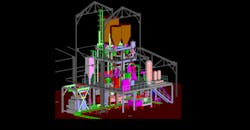Metalcasters are always working to eliminate scrap castings and improve product quality. Selecting the appropriate core-machine design and ancillary equipment is an important aspect of reducing casting defects and scrap. Even these objectives have some preliminary considerations, including determining the right coremaking process, selecting a tooling design, and observing effective record-keeping and maintenance practices.
Eliminating bad cores as a contributing factor to casting defects is not difficult, but it takes close monitoring and requires a well thought, thorough action plan. Initiating several simple process changes and maintenance procedures, and understanding the new core machine and its supporting systems can help deliver consistent-quality cores.
There are many core machine solutions to choose from, from entry-level prototype machines, semi-automatic, automatic, and on up to complete production cells for high-volume production.
First, consider the size and complexity of the cores to be produced. Typically, larger cores will be made lighter with mandrels or loose pieces for hollow areas. The most desirable cores are made as one piece, and multi-piece cores may be made into one-piece assemblies. Each machine must be considered for total cost of ownership, including a thorough review of initial capital costs, productivity, uptime, downtime, MTTR, utilities, PM maintenance, and competency of core-room operators.
When analyzing your core machine requirements, you must consider the entirety of your core production: the number of cores per tool (or core box), the number of cores per year, and your operating hours. With this data, an analysis of production times and potential improvements can be made that will help to identify the correct-size (blow capacity, box size) machine that meets the foundry’s needs now, and in the future.
When choosing the machine, a critical feature (and variable) will be the sand magazine and blow/exhaust system. Different manufactures have different solutions and capacities, including 50-, 100-, 300-, or 800-lbs. solutions. Some manufactures describe capacity in liters (10, 25, 40, 80, etc.); for reference, 10 liters is about 35 lbs. of sand capacity.
The sand is another important point. Sand entering the mixing system typically will be introduced from a localized silo (enough for several hours) or larger storage silo (days.) The sand should pass through a sand heater before entering the mixer: It is important to supply sand to the mixing system that is in the range of 75-90°F for optimal sand curing.
Depending on your location, you may want to include a properly sized sand heater (22.5-300 Kw for 100-2,000 lbs./min.) that is set up and maintained (many are nonfunctional in the field and clogged), along with resin binder heaters.
Preparation and mixing of the sand will come from a batch or high-speed continuous mixer: A batch mixer can be an open, S-blade mixer, vibratory, or a side-mounted Stator type. Similarly, like mulling green sand, you will need a predetermined amount of time to optimize mixing sand and binders, to achieve a homogenous mixture. Many foundries also use a continuous mixer for coremaking, which provides good sand mixing, on-demand or batched, as required.
For hot-box, warm-box, inorganic or shell cores, curing is a function of a heat-delivery system, the core box geometry, and the time required to properly react and cure the core for removal and handling. These curing methods typically are more time-consuming than traditional cold-box system.
A cold-box core is cured via gas generators that are designed specifically to deliver gas at a controlled pressure and temperature, typically followed by clean-air purge. A gas or amine that is introduced to start a chemical reaction allows the mix binder atop the coated sand to harden or cure. Several types of catalyst are available, including TEA, DMEA, DMIPA, SO2, CO2, or methyl formate.
Typically, the supply of curing air is provided by 3- to 40-Kw heaters. Using these heaters to purge warm air in the tooling before starting up is an excellent feature that improves start-up for coremaking. Depending on the actual amine being used to cure, temperatures may range from 100° to 250°F. Consult a binder supplier to learn the flash point and critical temperatures of your particular catalysts. Remember, just because you set a controller to 240°F, doesn’t mean that the internal heating elements are 1,000°F! Off-the-shelf heaters are designed for continuous, not intermittent air flow, so be careful.
An efficient gas generator, coupled with the most effective catalyst will help to reduce the amount of catalyst consumed. This will pay off downstream because less gas means fewer emissions, reducing scrubbing and acid costs.
Typically, for the cold-box process the above-mentioned catalyst gases will have to be captured upon exit from the process, and scrubbed. A common scrubber provides a certain CFM pull on the core box directly, or on the enclosure.
This acid-type scrubber "bubbles" the retrieved air with gas through a water/acid solution. These typically are rated for 99%, 99.9% or 99.99% efficiency. The numbers following the decimal are really important and should be discussed thoroughly before making a decision. Higher precision usually means a larger sump and/or a taller scrubber tower, which influences the overall cost of the units.
These are the key components of a core cell system. Many more items go into your specific solution to complete the core room plan. Once that plan is complete, the engineering design, build, location and installation are all critical. Before you finalize your Gantt chart, you will need to consult local or state laws for proper permits, as obtaining installation permits may take over six months.
Jerry Senk is the president of Equipment Manufacturers International Inc. Contact him at LinkedIn, or visit www.emi-inc.com
